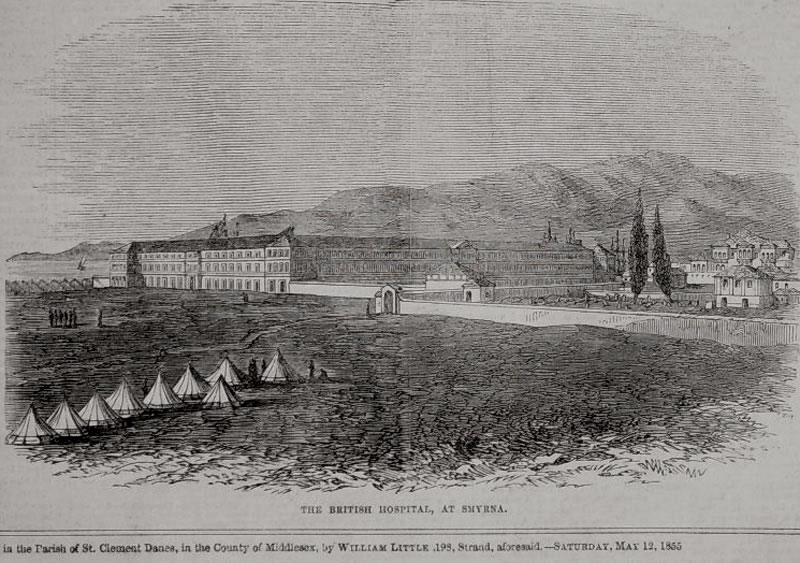 |
The Crimean War period hospital of Smyrna. According to the Anglican Church Building Committee minutes, the ‘Old Hospital’ was eventually rented to the Greek community for use as an orphanage and it may still have been standing in 1922 - After the Crimean War, this building was referred to in local British archives as the ‘Old Hospital’ (to distinguish it from the British Seaman’s Hospital) was located more towards the waterfront, to the west of the British Consulate. Its site is evident on the 1905 Goad maps (though under a different name). Further details from Donald H. Simpson’s unpublished 1952 book ‘Anglican Church Life in Smyrna and its neighbourhood 1636-1952’:
(pp. 29-30) “In 1733 a house was acquired for use as a hospital [...] The exterior of the hospital was paved, following the example of the Dutch, in 1737.”
(p. 34) in the context of a fire and riots in August 1763: “in the course of which damage was done to the Frank quarter, including the British Consulate and Hospital.”
(p. 36) in the context of 1786: “Mr Howard noted with pleasure the English Hospital (recently repaired), the new Diutch Hospital almost opposite, and those supported by the Venetians, French, Jews, and Greeks."
(p. 44) in the context of 1810: “John Cam Hobhouse, visiting the city at this time, noted that there was neither a physician for the hospital nor a Chaplain...”
(p. 55) in the context of the dissolution of the Levant Compnay in 1825: “On May 19th the Company wrote to the Smyrna Factory asking that a report should be made on the Consular House, Chapel, Chaplain’s residence, and Hospital, which were to be transferred to the Government.”
(p. 64) reference to the consecration of the “Hospital Cemetery” on 22 April 1843 - this is not to be confused with the older English Cemetery at Saint Veneranda or the Crimean War Cemetery - see below
(pp. 68-69): “The ensuing winter [of 1854-55] was a time of terrible hardship, and disease, cold and hunger took a heavy toll. The inadequate hospitals in the Crimea, and at Scutari, near Constantinople, were filled to overflowing, and early in the new year the Turkish Barracks at Smyrna were adapted for use as an additional hospital. The building was not altogether suitable, nor was its situation, to the south of the city, very healthy [...] Those who died in the hospital at Smyrna were buried in a special cemetery to the south-west of the city, near the Jewish Cemetery [...] an obelisk of soft stone [...] was placed in the centre...” So the hospital building shown in the engraving dated May 1855, is obviously the Ottoman barracks at Konak.
(p. 73-74) “the St. Veneranda [burial] ground was long since disused [...] in 1866 the Turkish authorities, in pursuance of their policy against intra-mural burials, informed the Consul that the Hosital Cemetery, which had about 140 graves, marked and unmarked, and room for others, could not be used any more [...] The third cemetery was the Crimean War Cemetery; this was in a bad state [...] removal of the obelisk to the proposed new cemetery [at Kemer] [...] was done in 1874-1875, and 28 coffins containing remains were re-interred there on 5th June 1875...” I wonder what happened to these remains when the British Cemetery at Kemer was destroyed in the 1980s? As war graves they should have been moved to a British military cemetery... The original English hospital established by the Levant Company was located, at least until the 1860s, near the Dutch hospital - and we all know where that was, thanks to the survival of its chapel (Agia Photini) and burial ground.
I have taken a closer look at the St John Church Minutes Book from the London Metropolitan Archives, and the “Old Hospital” mentioned there - the one near the Consulate - is clearly designated the old British Seaman’s Hospital. So it is obviously a separate entity from the Levant Company foundation, and a predecessor of the “new" British Seaman’s Hospital in Punta, which was already functioning in 1895.
Analysis courtesy of George Vassiadis, 2011
(p. 34) in the context of a fire and riots in August 1763: “in the course of which damage was done to the Frank quarter, including the British Consulate and Hospital.”
(p. 36) in the context of 1786: “Mr Howard noted with pleasure the English Hospital (recently repaired), the new Diutch Hospital almost opposite, and those supported by the Venetians, French, Jews, and Greeks."
(p. 44) in the context of 1810: “John Cam Hobhouse, visiting the city at this time, noted that there was neither a physician for the hospital nor a Chaplain...”
(p. 55) in the context of the dissolution of the Levant Compnay in 1825: “On May 19th the Company wrote to the Smyrna Factory asking that a report should be made on the Consular House, Chapel, Chaplain’s residence, and Hospital, which were to be transferred to the Government.”
(p. 64) reference to the consecration of the “Hospital Cemetery” on 22 April 1843 - this is not to be confused with the older English Cemetery at Saint Veneranda or the Crimean War Cemetery - see below
(pp. 68-69): “The ensuing winter [of 1854-55] was a time of terrible hardship, and disease, cold and hunger took a heavy toll. The inadequate hospitals in the Crimea, and at Scutari, near Constantinople, were filled to overflowing, and early in the new year the Turkish Barracks at Smyrna were adapted for use as an additional hospital. The building was not altogether suitable, nor was its situation, to the south of the city, very healthy [...] Those who died in the hospital at Smyrna were buried in a special cemetery to the south-west of the city, near the Jewish Cemetery [...] an obelisk of soft stone [...] was placed in the centre...” So the hospital building shown in the engraving dated May 1855, is obviously the Ottoman barracks at Konak.
(p. 73-74) “the St. Veneranda [burial] ground was long since disused [...] in 1866 the Turkish authorities, in pursuance of their policy against intra-mural burials, informed the Consul that the Hosital Cemetery, which had about 140 graves, marked and unmarked, and room for others, could not be used any more [...] The third cemetery was the Crimean War Cemetery; this was in a bad state [...] removal of the obelisk to the proposed new cemetery [at Kemer] [...] was done in 1874-1875, and 28 coffins containing remains were re-interred there on 5th June 1875...” I wonder what happened to these remains when the British Cemetery at Kemer was destroyed in the 1980s? As war graves they should have been moved to a British military cemetery... The original English hospital established by the Levant Company was located, at least until the 1860s, near the Dutch hospital - and we all know where that was, thanks to the survival of its chapel (Agia Photini) and burial ground.
I have taken a closer look at the St John Church Minutes Book from the London Metropolitan Archives, and the “Old Hospital” mentioned there - the one near the Consulate - is clearly designated the old British Seaman’s Hospital. So it is obviously a separate entity from the Levant Company foundation, and a predecessor of the “new" British Seaman’s Hospital in Punta, which was already functioning in 1895.
Analysis courtesy of George Vassiadis, 2011
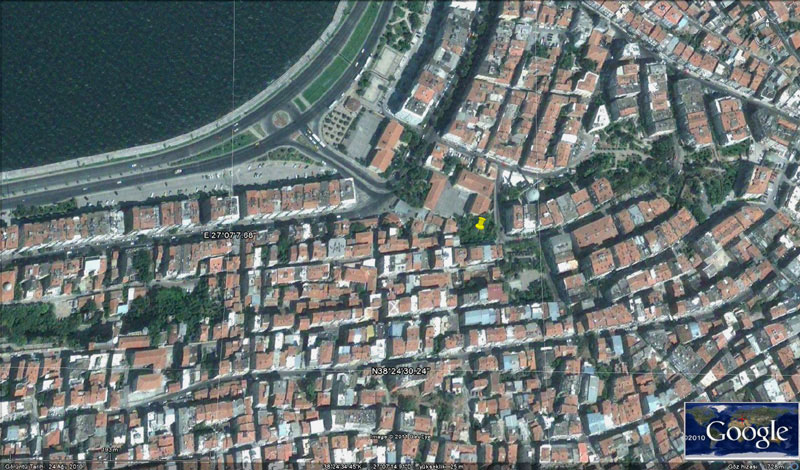 |
The location of the British military cemetery in modern Izmir - old map view. The site is now the Hacı Şakir Eczacıbaşı primary school. Today nothing is left from the graves - information courtesy of Andrew Simes, 2011. The nearby Women’s and Birth Hospital were also within the old cemetery zone:
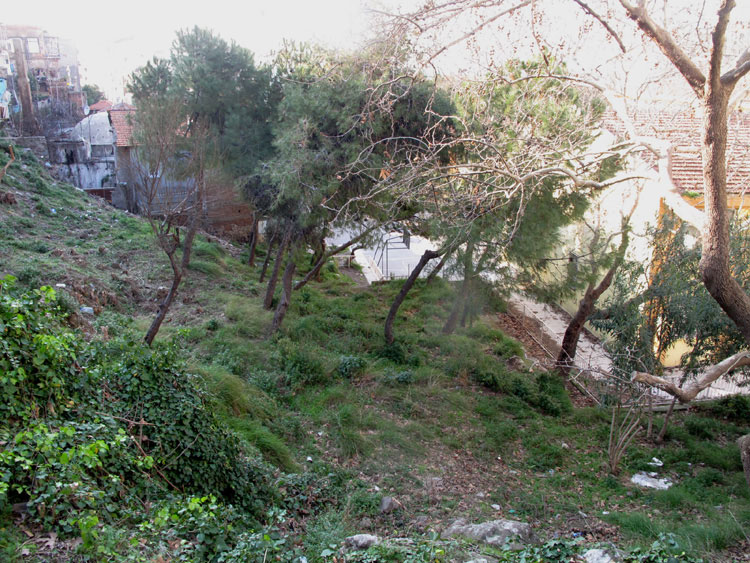 |
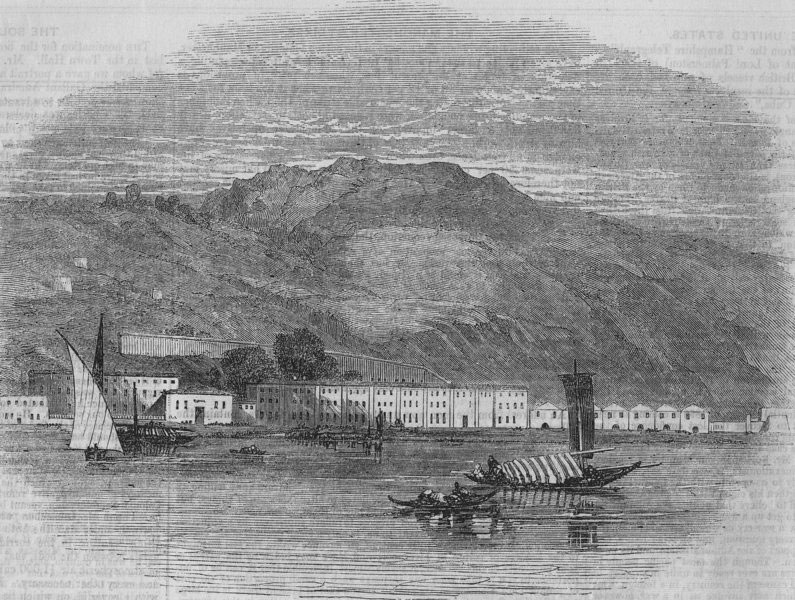 |
The location of the Sanatorium in Smyrna, published in 1855, is possibly along the coast at the thermal spa of Agamenon (modern Balçova) - view
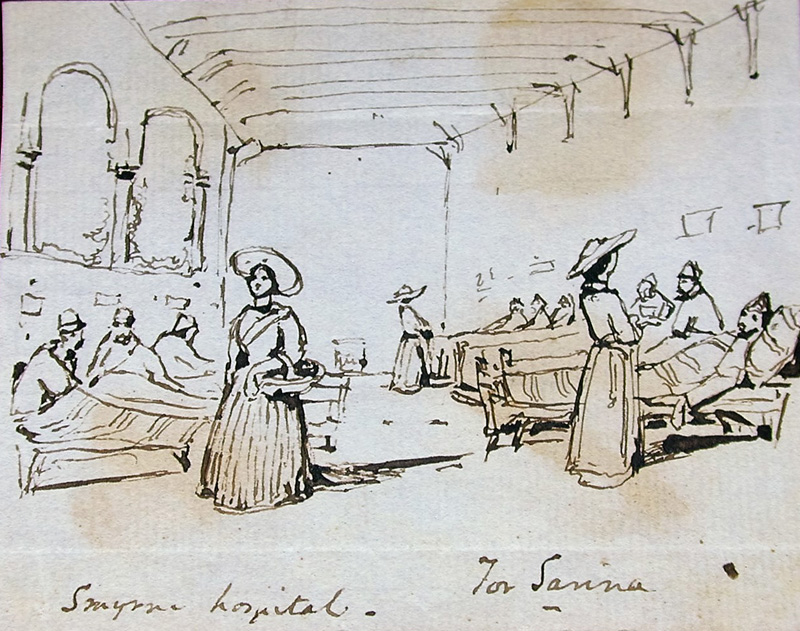 |
A rough drawing of a ward of this hospital presumably drawn by a patient or possibly a doctor in the hospital during the Crimean War.